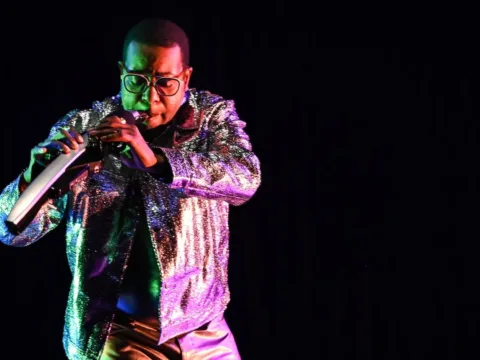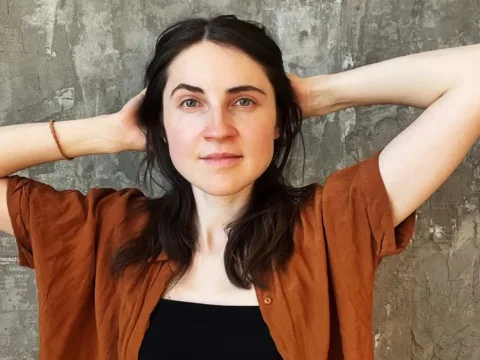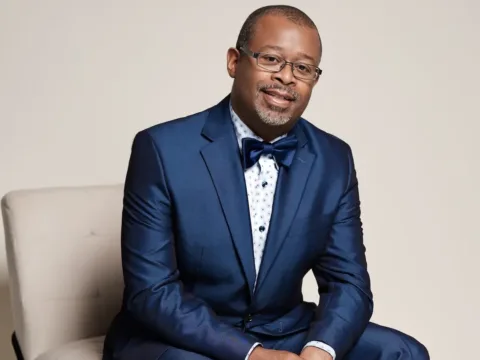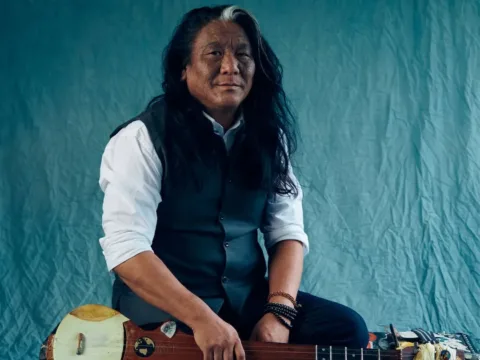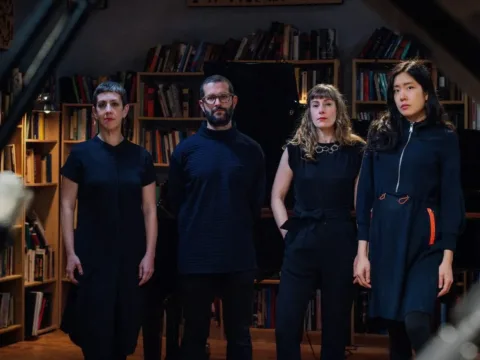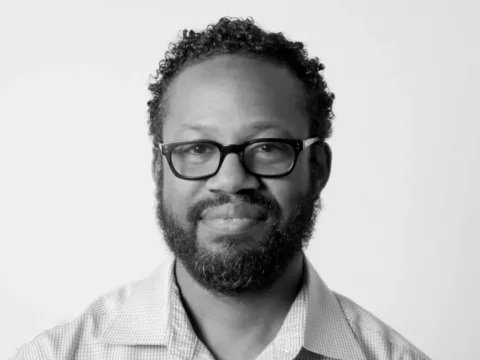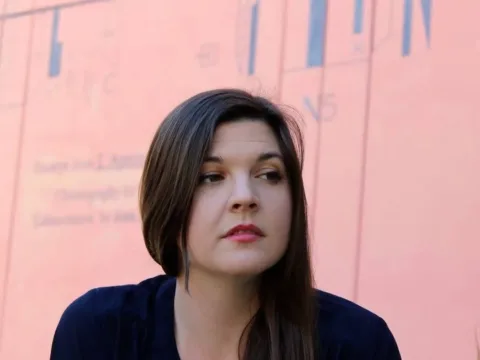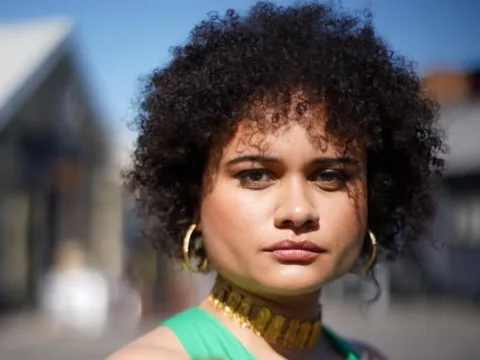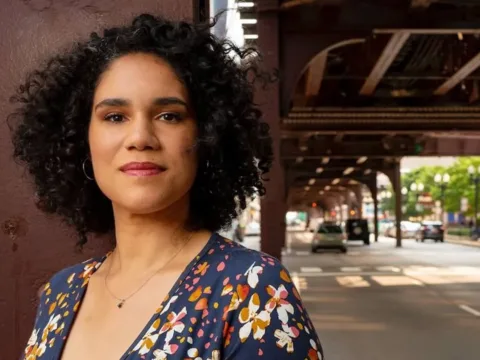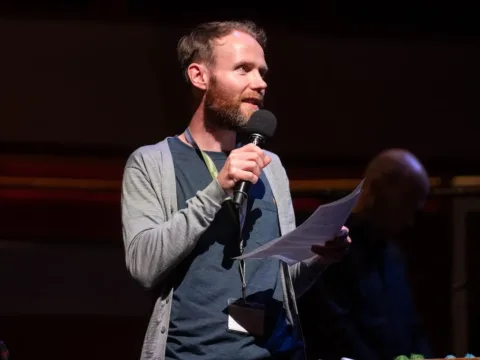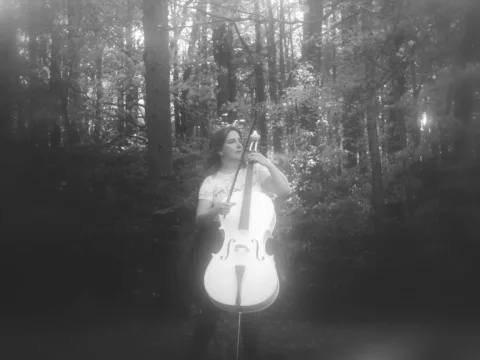This article was commissioned by American Composers Forum.
When composer Jerod Impichchaachaaha’ Tate went on a pilgrimage with his grandmother to their Chickasaw tribe’s old homelands in 1994, he knew the journey would inspire a new symphonic piece. The resulting career-defining flute concerto, Tracing Mississippi, is about the Chickasaw composer’s “deep spiritual and psychological experience” of driving up and down Natchez Trace, an old trade route leading to Natchez, Mississippi, along the heart of Chickasaw and Choctaw territories. It’s a notable achievement from Tate’s unambiguous career goal to represent his identity as both a symphonic composer and a citizen of the Chickasaw Nation in Oklahoma, where he was born. The son of Charles Tate, a tribal judge and author of the current Chickasaw Constitution, Tate grew up “with a wonderful, robust knowledge and experience of North American Indian tribal history, law, and politics,” he says.
With that history in mind, the concerto, which was written for soloist Christine Bailey Davis, traces the roots of Tate’s family back to the mass exodus of the 1830s, when the Chickasaws and other American Indian tribes were displaced from northern Mississippi and Alabama to Oklahoma. Like all his compositions, Tracing Mississippi employs or alludes to tribal music, whether Chickasaw, or Choctaw, Navajo, Cherokee, Lakota, Hopi, or Comanche, among others.
Although the tribal music references are prevalent in his music, Tate takes a conscious, impressionistic route for abstracting the culture his music represents. In his scores, he transcribes the melodies and manipulates them, augmenting or playing them backwards, much like Béla Bartók used to do. An ethnomusicologist, Bartók “was preserving his own folk music and leaning into it as his theoretical material for all of his compositions,” says Tate, who was inspired by Bartók’s compositional method to explore his ethnic heritage.

“I’m avoiding that cartoony Indian tom-tom sound,” he says, delineating the way his own method relates to a historical cross-cultural tradition. “We have a genre of fine art within Native American culture that dates 150 years. People fly to the Santa Fe Indian Market to purchase modern native art, which uses materials that are not aboriginal to our cultures. If you’re comparing symphonic music, you’ve got Russian composers like Tchaikovsky, Prokofiev, and Rachmaninoff, who infused their ethnic and national identity into their symphonic music, and we’re talking folk music that wasn’t originally symphonic. And when you look at more modern folks like Tōru Takemitsu or Chinary Ung, who are Japanese and Cambodian, Takemitsu sounds entirely Japanese, and Ung sounds Cambodian. They are transporting their cultural ethos into the symphonic medium that is available to the entire world. The orchestra is a glorious culture that’s been developed for a long time. It’s very refined, and the symphonic medium is really useful for all cultures to express themselves as modern artists in their own culture.”
This abstraction guides the performance practice that Tate is cultivating for his vocal music, in particular. His Chickasaw-language texts are conceptual impressions of his self-image “as a person on the planet and a Chickasaw man, reflecting my feelings of being in touch with my identity through music.” Iholba’ (The Vision), which premiered at the Kennedy Center in 2005 and will be performed at Carnegie Hall in 2023, was the first classical choral work entirely in the Chickasaw language. Tate’s choral music is dignified and calculated; the first movement of Iholba’ opens with subdued voices that later diminish to near silence. After more than 10 minutes of calm, the chorus erupts into forte declamations underlined by percussion. It’s an arresting moment.
A three-time American Composers Forum (ACF) commissioned artist, Tate has also written for youth choir through ChoralQuest, an ACF program that commissions new music to supplement the standard middle school choral repertoire. In Taloowa’ Chipota (Children’s Songs), he combines a three-part mixed children’s choir with wordless vocal undulations, solo cello harmonics, shell shakers, and piano, to dreamy effect. The music is set to a Chickasaw text about stomp dancing — “the moment of repose before the final dance when the sun is coming up,” says Tate. The second movement uses vocables, or syllables evocative of the tribal call-and-response characteristic of Chickasaw music. It was premiered in 2012 by the Dickson Middle School Choir, in the Chickasaw Nation.
“I saturated the kids with all of those elements, along with some modern writing,” says Tate. “When I do these works with kids, I like to treat them as students and introduce them to different techniques. I’m so fortunate that ACF trusted me and asked me to be part of [the program].”
His largest work to date is Lowak Shoppala’ (Fire and Light), which was commissioned by ACF’s Continental Harmony project and premiered in 2009. Structured in eight scenes, with a libretto by Chickasaw poet Linda Hogan, the theater piece dramatizes Chickasaw history and culture. It calls for orchestra, narrators, children’s chorus, and dancers. Tate partnered with the Oklahoma Youth Orchestra and Oklahoma City University, among other groups from his community, and first staged Lowak Shoppala’ at the Chickasaw Nation Headquarters in Ada, about 55 miles from Oklahoma City.
Tate’s association with ACF has been indispensable for his development as a composer who is deeply committed to his Chickasaw heritage. “They commissioned three important works of mine at different stages of my writing; they have been a consistent presence in my life,” he says. Besides Taloowa’ Chipota and Lowak Shoppala’, ACF supported the creation of Nitoshi’ Imali (Little Bear Song) through the First Nations Composer Initiative (2004 – 2010). The three-movement concerto for guitar and orchestra incorporates Lakota tunes and was written for soloist Jason Vieaux, an esteemed colleague from the Cleveland Institute of Music, where Tate earned a master’s degree in piano and composition. For the theme-and-variations second movement, he took inspiration from Rachmaninoff’s Rhapsody on a Theme of Paganini, aiming for a guitar piece of similar proportions.
More recently, Tate’s Ghost of the White Deer, a bassoon concerto originally commissioned by the Dallas Symphony, was performed by the Indianapolis Symphony and principal bassoon Ivy Ringel in May 2022. His string quartet Pisachi (Reveal) also caught on and has had several performances in the last two years. Commissioned by ETHEL, the quartet captures Tate’s episodic and sometimes clamorous depiction of the Southwest American Indian culture on their 2015 album Documerica (on ACF’s innova Recordings).
What Tate ultimately finds most artistically satisfying is the storytelling through music, delving into Chickasaw history and culture and allowing him to embrace “being an American and an American Indian at the same time.” As a 2022 inductee into the Chickasaw Hall of Fame, he comments, “There’s a lot of folks in the tribe who deserve this recognition. I’m accepting it on behalf of my entire nation; everybody in the tribe is responsible for where we are right now, for all the success we share amongst ourselves.”
I CARE IF YOU LISTEN is an editorially-independent program of the American Composers Forum, funded with generous donor and institutional support. Opinions expressed are solely those of the author and may not represent the views of ICIYL or ACF.
A gift to ACF helps support the work of ICIYL. For more on ACF, visit the “At ACF” section or composersforum.org.

